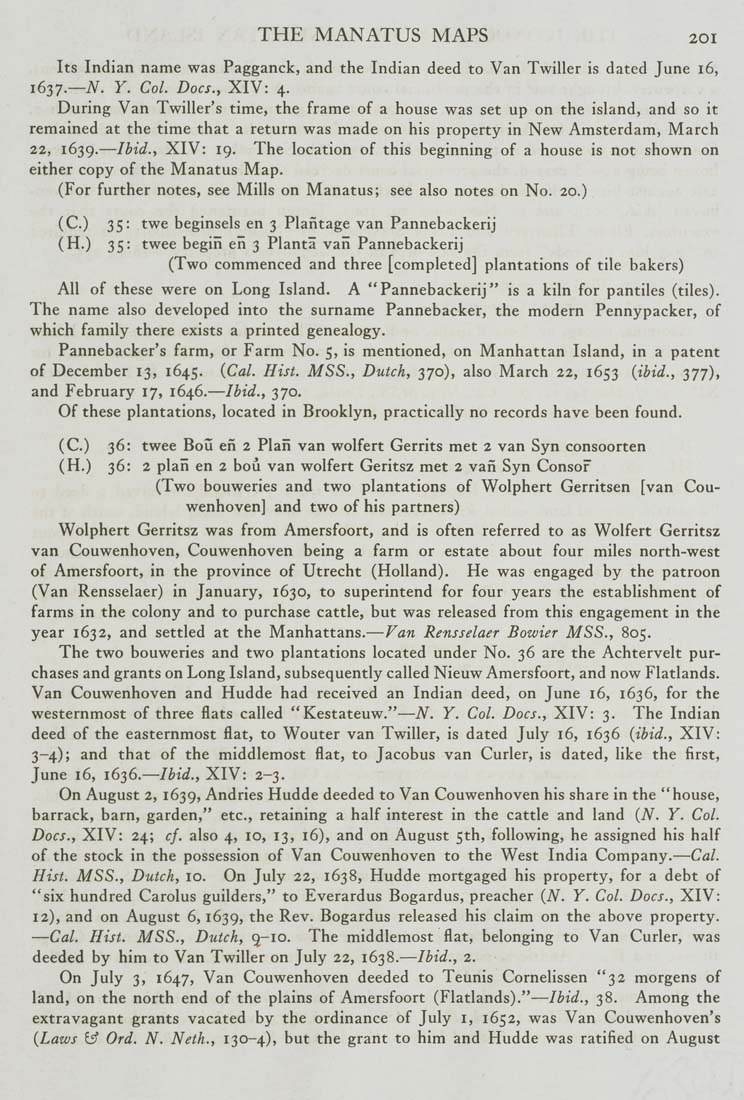THE MANATUS MAPS 201
Its Indian name was Pagganck, and the Indian deed to Van Twiller is dated June 16,
1637.—AT. Y. Col. Docs., XIV: 4.
During Van Twiller's time, the frame of a house was set up on the island, and so it
remained at the time that a return was made on his property in New Amsterdam, March
22, 1639.—Ibid., XIV: 19. The location of this beginning of a house is not shown on
either copy of the Manatus Map.
(For further notes, see Mills on Manatus; see also notes on No. 20.)
(C.) 35: twe beginsels en 3 Plaiitage van Pannebackerij
(H.) 35: twee begiii en 3 Planta vaii Pannebackerij
(Two commenced and three [completed] plantations of tile bakers)
All of these were on Long Island. A "Pannebackerij" is a kiln for pantiles (tiles).
The name also developed into the surname Pannebacker, the modern Pennypacker, of
which family there exists a printed genealogy.
Pannebacker's farm, or Farm No. 5, is mentioned, on Manhattan Island, in a patent
of December 13, 1645. {Cal. Hist. MSS., Dutch, 370), also March 22, 1653 {ibid., 377),
and February 17, 1646.^—Ibid., 370.
Of these plantations, located in Brooklyn, practically no records have been found.
(C.) 36: twee BoS eii 2 Plan van wolfert Gerrits met 2 van Syn consoorten
(H.) 36: 2 plaii en 2 bou van wolfert Geritsz met 2 vaii Syn ConsoF
(Two bouweries and two plantations of Wolphert Gerritsen [van Cou¬
wenhoven] and two of his partners)
Wolphert Gerritsz was from Amersfoort, and is often referred to as Wolfert Gerritsz
van Couwenhoven, Couwenhoven being a farm or estate about four miles north-west
of Amersfoort, in the province of Utrecht (Holland). He was engaged by the patroon
(Van Rensselaer) in January, 1630, to superintend for four years the establishment of
farms in the colony and to purchase cattle, but was released from this engagement in the
year 1632, and settled at the Manhattans.—Van Rensselaer Bowier MSS., 805.
The two bouweries and two plantations located under No. 36 are the Achtervelt pur¬
chases and grants on Long Island, subsequently called Nieuw Amersfoort, and now Flatlands.
Van Couwenhoven and Hudde had received an Indian deed, on June 16, 1636, for the
westernmost of three flats called "Kestateuw."—A^. Y. Col. Docs., XIV: 3. The Indian
deed of the easternmost flat, to Wouter van Twiller, is dated July 16, 1636 {ibid., XIV:
3-4); and that of the middlemost flat, to Jacobus van Curler, is dated, like the first,
June 16, 1636.—Ibid., XIV: 2-3.
On August 2, 1639, Andries Hudde deeded to Van Couwenhoven his share in the "house,
barrack, barn, garden," etc., retaining a half interest in the cattle and land {N. Y. Col.
Docs., XIV: 24; cf. also 4, 10, 13, 16), and on August 5th, following, he assigned his half
of the stock in the possession of Van Couwenhoven to the West India Company.—Cal.
Hist. MSS., Dutch, 10. On July 22, 1638, Hudde mortgaged his property, for a debt of
"six hundred Carolus guilders," to Everardus Bogardus, preacher {N. Y. Col. Docs., XIV;
12), and on August 6,1639, the Rev. Bogardus released his claim on the above property.
—Cal. Hist. MSS., Dutch, 9-10. The middlemost flat, belonging to Van Curler, was
deeded by him to Van Twiller on July 22, 1638.—Ibid., 2.
On July 3, 1647, Van Couwenhoven deeded to Teunis Cornelissen "32 morgens of
land, on the north end of the plains of Amersfoort (Flatlands)."—Ibid., 38. Among the
extravagant grants vacated by the ordinance of July i, 1652, was Van Couwenhoven's
{Laws y Ord. N. Neth., 130-4), but the grant to him and Hudde was ratified on August
|








